Photoville 2015: A Literate Lens Sampler
 There was rain forecast for later in the day, but in the meantime the weather was balmy and perfect. A light breeze was blowing off the East River, and across the water, Manhattan’s skyscrapers were exhibiting their sleek, glittery surfaces. The shipping containers were wired up, the shows hung. It was time for Photoville, 2015 edition.
There was rain forecast for later in the day, but in the meantime the weather was balmy and perfect. A light breeze was blowing off the East River, and across the water, Manhattan’s skyscrapers were exhibiting their sleek, glittery surfaces. The shipping containers were wired up, the shows hung. It was time for Photoville, 2015 edition.
The first Photoville, in 2012, was a welcome addition to New York’s photography scene. With its casual vibe, the festival attracted photo folks, but also people who wouldn’t normally be drawn to such an event. The waterfront location, the indoor-outdoor exhibits, the beer garden and food court made this a less intimidating environment than the typical white-cube Chelsea art gallery.
In 2013 and 2014, Photoville built on the success of its first year and moved along the waterfront to Brooklyn Bridge Park, giving it room to expand. Last year, I wrote that the festival had “grown up,” having been an exuberant toddler in 2012 and a scrappy adolescent in 2013. I was curious to see what 2015 would bring.
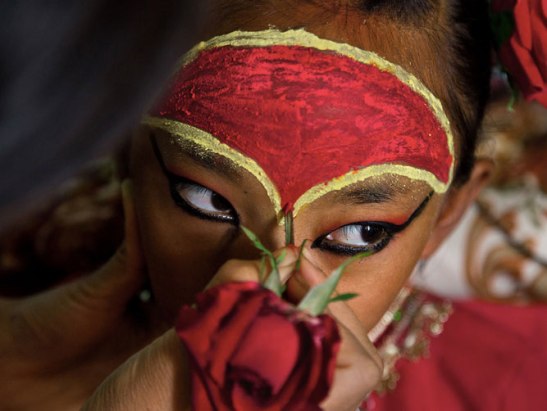
From an outdoor installation: In Nepal, certain young girls are chosen as kumari, or living goddesses. Photo (c) Stephanie Sinclair/National Geographic
And perhaps it was the day I attended (last Saturday), or the events I chose, but it seemed to me that this year brought… girl power. Which is to say, there were many exhibitions by women artists doing extremely powerful work, and also a conspicuously high proportion of women panelists and presenters.
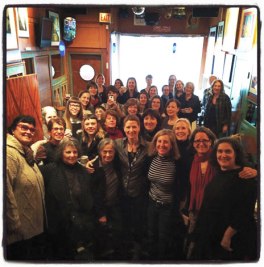
Chicago Women in Photography (CWIP) is one of many new women’s photography groups. Photo courtesy Meg Handler.
Perhaps propitiously, the day started with a meeting of the newly formed Women’s Photo Alliance (WPA) in the beer garden. For the September issue of Photo District News (which, incidentally, was focused entirely on women), I wrote an article about the women’s photography networks and groups that have been forming in recent years. There are many, of all different types and sizes, but all are focused on helping women photographers network and advance their work.
The newest of the bunch, WPA was started by the lovely Jennifer McClure, a fine art photographer who had noticed that women were vastly under-represented in the New York gallery world. When I asked Jen how she was dealing with those reduced opportunities, she memorably answered, “Instead of going back to the same shrinking pie, [women] should be thinking… How do we make more pies?” Judging by the turnout at Photoville, and by the excitement the group has generated since its launch last June, you can expect those pies to be scenting the air soon.
From the WPA meeting I went to a panel presentation called The Virtual and the Physical: Responses to Photography in the Digital World. Moderated by the esteemed Fred Ritchin (who was recently named dean of the ICP School of Photography), the panel consisted of two women artists, Rita Leistner and Penelope Umbrico, talking about their various uses of digital media.
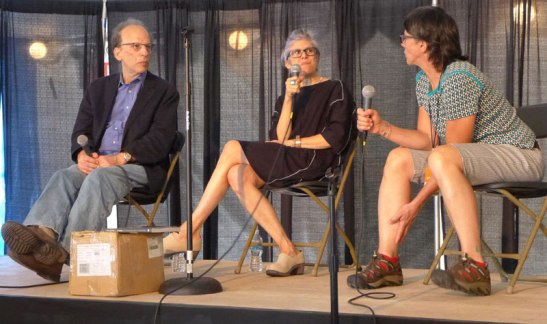
Fred Ritchin, Penelope Umbrico and Rita Leistner discuss how photography is meeting the digital revolution. Photo (c) Sarah Coleman
In his 2013 book Bending the Frame, Ritchin argues that in the age of digital proliferation, photographers must think outside the box and reinvent the medium. He asks, “What new approaches are conceivable in an era many now call ‘postphotographic’—when the image output from a camera is no longer thought of as being, or needing to be, above all a recording?”
Leistner and Umbrico offered some possibilities. Leistner, who was invited to participate in a “social media experiment” while embedded with the United States Marine Corps in Helmand province, Afghanistan, chose to photograph for the first time with an iPhone and the Hipstamatic app. Although she “quickly fell in love with it,” she said, the digital interface and dizzying abundance of images also made her feel removed from the process—a relationship she likened to soldiers being distanced from killing by the use of ultra-sophisticated technology. However, an encounter with the work of Marshall McLuhan, the father of media studies, led her to see her experience as part of a continuum in the evolution of technology. (Her interesting complete series of images, with accompanying essays, can be seen here.)
Umbrico, on the other hand, is interested in abundance and volume: her work investigates social trends by pulling amateur photos from public sites like Flickr and craigslist. She trawls these photographs for hidden symbols: for example, huge numbers of photographs of televisions for sale on craigslist show the seller reflected in the television screen, or a dog by the television, whose appearance shows “the empathetic relationship between the pet and the person taking the photo.”
Of course, the appropriation of such images can be discomforting—especially for the people who shot them. Umbrico acknowledged this, and talked about deciding not to name individual photographers. “I realized I couldn’t give attribution to each photographer because that would destroy the collective aspect,” she said. Whether that seems correct or convenient is obviously a matter for individual contemplation.
Later in the day, I was among a packed audience for Influencing Policy and Social Change through Photography, a panel moderated by Parsons photography professor Michelle Bogre that featured three female social documentary photographers with some of the most powerful container exhibits in the festival: Stephanie Sinclair, Debi Cornwall and Brooke Singer.

Kiddie Pool (left) and Recreation Pen, Camp Echo (right), from Gitmo at Work, Gitmo at Play. Photo (c) Debi Cornwall
I wrote about Sinclair in my last blog post, Too Young to Wed: The Tragedy of Child Marriage. Her work to end the scourge of child marriage worldwide is nothing short of heroic, and when she showed images of children as young as five being wed, the shock in the audience was palpable. “After doing this project, I do believe in the power of photography to change minds,” she asserted, referencing a topical example—the previous week’s image of drowned Syrian toddler Aylan Kurdi—as “one of those moments when people get stopped in their tracks.”
If Sinclair’s work was disturbingly real, Cornwall’s project, Gitmo at Work, Gitmo at Play offered a surreal twist on typical images of Guantanamo Bay. Informed by her military escort that Guantanamo was “the best posting a soldier could have,” Cornwall (a former civil rights lawyer) asked to be shown the fun, and was taken to tropical beaches, tiki bars and U.S. military bowling alleys. Put side-by-side with more familiar depictions of detainee cells and prisoner “comfort items,” these images are shocking, forcing viewers to re-examine their preconceptions about the controversial camp.
Closer to home, Brooke Singer is documenting Superfund sites across the U.S. and showing the results on ToxicSites.US, an interactive website she launched at Photoville. Initially, Singer was inspired by a conversation she had with a former EPA ombudsman, Robert J. Martin, who told her that “after 9/11, the whole of lower Manhattan should have been a Superfund site.” The information she has amassed is terrifying, but impressive in its clarity and accessibility. (See, for example, the page on Scientific Chemical Processing, one of three sites in New Jersey, just across from upper Manhattan.) Like Sinclair, Singer recognizes the power of photography to galvanize people, so she and others are now documenting many sites and writing blog posts about them.
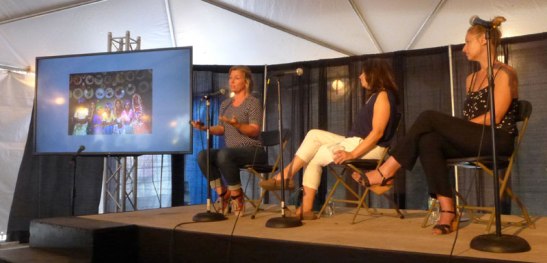
Stephanie Sinclair (left), Brooke Singer (center) and Debi Cornwall (right) discuss influencing social policy through photography. Photo (c) Sarah Coleman
It was inspiring to see this work, and to see an all-female panel after years of attending panels that have been either all-male or else have included a token woman. (Some racial diversity would have been nice too, but you can’t have everything—and next weekend does feature a panel of black photographers documenting recent racial tensions in America.)
This year, Photoville has also made a valiant effort to include more emerging photographers through a program called ‘Emergi-Cubes,’ where established curators have chosen photographers to be exhibited. It’s a great idea, but I have to say that the ground-level cubes—made from shipping pallets nailed together—were hard to view and didn’t do justice to the strong work on their sides. If this program continues next year, it would be great to mount each cube on top of a plain cube, for better viewing.
Photoville continues this weekend. The entire schedule can be found here, but here are some of my picks:
CONTAINER EXHIBITIONS
Glenna Gordon: Diagram of the Heart
Brooklyn-based photojournalist Gordon has been documenting the very unexpected lives of female Muslim romance novelists in northern Nigeria.
Misha Friedman: The Iron Closet
Being gay in Russia is lonely and extremely dangerous. Friedman’s beautiful portraits and heartfelt testimonies illuminate individuals who have made this brave choice.
Upstate Girls: Unraveling Collar City
Veteran photographer Brenda Ann Kenneally curates a rich, messy survey of the lives of teenage girls over many years in an upstate blue collar town.
PANELS
Saturday Sept. 19, 1-2 p.m. Photography Restaged
Another all-female panel, this one features three art photographers, Lori Nix, Rose DeSiano and Lorie Novak, who use intricately-built models, re-enacted theatrics and staged installations to draw attention to the uncanny state of the real world.
Sunday Sept. 20, 2:45-3:45 Under Fire: Black Photographers Creating Agency in a ‘Post-Racial’ America
Photographers Devin Allen, Sheila Free Bright and Radcliffe Raye discuss their recent coverage of the resurgence of violence against African-Americans and the ensuing outrage.
WORKSHOPS
Saturday Sept.19, 5-6:30 p.m. InstaReview
Want to grow your following on Instagram and/or monetize it? Four photographers who have successfully done so reveal their tips.
Sunday Sept. 20, 2-4 p.m. Make What You Make Look Great
If you’re a baker or maker who wants to take better images of your wares, this one is for you. Top food photographer Evi Abeler will give tips on how to make your products shine.
NIGHTTIME EVENTS
Saturday Sept. 19, 7 p.m. An Evening with National Geographic
One hundred and twenty-seven years young, National Geographic is one of the last bastions of in-depth, complex visual storytelling. The magazine will show photos and videos from its 127-year history, and from its recent digital platforms. NatGeo photographers Stephanie Sinclair, Katie Orlinsky, Robert Clark and David Guttenfelder will be on hand to talk about their work.
6 comments on “Photoville 2015: A Literate Lens Sampler”
Leave a Reply
Connecting to %s

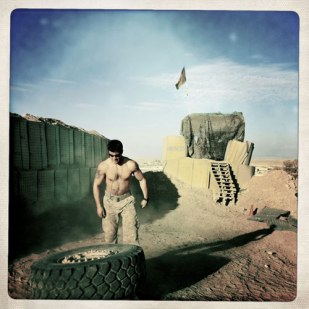
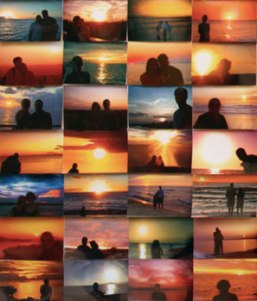
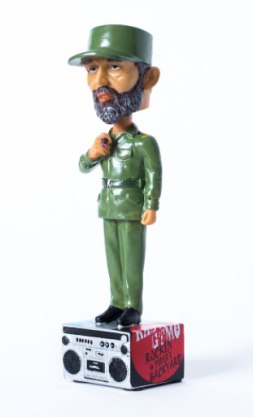

Fellow women, rock on!
Sounds amazing – well written article too – wish I could make it to see the exhibition but reading about it is pretty good! Joanna
An interesting exhibition – your enthusiastic description makes it a real festival!
Loved it all, but particularity keen on the sage wisdom of Jennifer McClure and the bit on Penelope Umbrico’s study of images on social media. As an amateur iphone photo enthusiast myself, I spend a decent amount of time looking at Instagram images and also am looking for commonalities. Thanks for posting this. I’ll have to visit Photoville one day!
this is incredible. there are no such groups and events like this where i live. i might skip across the pond one day and visit Photoville.
Loved reading this to discover all the exciting pushing of boundaries women are doing with the way they see.